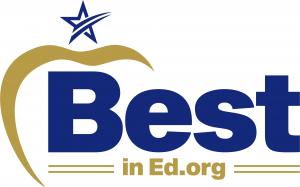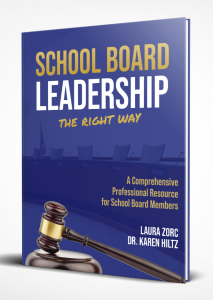Best In Ed, Formally Launches The National School Boards Coalition (NSBC) To Support School Board Members And Partners
NSBC is bringing together school board candidates and elected members nationwide, going beyond just professional development.
The NSBC is poised to be an alternative to the National School Boards Association (NSBA). With increasing demand from school board members for an alternate organization emphasizing quality education, limited government, transparency, and accountability, the NSBC is set to lead a united effort focused on collaborating with parents, educators, and the community to support students in traditional and nontraditional educational settings.
“When board members are well-supported, students can succeed,” said Laura Zorc, President of Best In Ed and former school board chairman. “The goals of the National School Board Coalition are to support and unite members and partners across the nation under the motto 'E Pluribus Unum'—' Out of many, (we are) one.'", "And, we know that many members want to transform education in their communities, but lack the support to challenge the status quo."
Since 2020, Best In Ed has trained parents to run for school board positions, resulting in hundreds of successful wins. This initiative has led to the creation of the school board mentorship program in 2023 and the recent release of a comprehensive 43-lesson professional development curriculum that provides valuable lessons for newly elected and existing members. The culmination of these efforts has led to the official formation of the NSBC, designed to exist in perpetuity.
The NSBC currently mentors over 1,000 school members and continues to grow daily. As school board elections approach, membership is expanding at an impressive rate. A dedicated website is coming soon.
Dr. Karen Hiltz, Vice President of Best In Ed, said, “Over the last five years, we have built a robust support system and network for our members to thrive in their roles, and this is a natural next step for the organization.”
For more information about the National School Boards Coalition and its initiatives, please visit www.BestInEd.org.
Dr. Karen Hiltz
Best In Ed
+1 202-455-9845
email us here
Legal Disclaimer:
EIN Presswire provides this news content "as is" without warranty of any kind. We do not accept any responsibility or liability for the accuracy, content, images, videos, licenses, completeness, legality, or reliability of the information contained in this article. If you have any complaints or copyright issues related to this article, kindly contact the author above.
Face Compact Market to Reach USD 2.2 Billion By 2031, Top Impacting Factors
USEA To Hold Press Briefing on Data Centers Upending Electric Utilities
The Chopin Law Firm Secures $2 Million Settlement in Commercial Vehicle Injury Case
Więcej ważnych informacji
 Jedynka Newserii
Jedynka Newserii

 Jedynka Newserii
Jedynka Newserii

Farmacja

Nowy pakiet farmaceutyczny ma wyrównać szanse pacjentów w całej Unii. W Polsce na niektóre leki czeka się ponad dwa lata dłużej niż w Niemczech
Jeszcze pod przewodnictwem Polski Rada UE uzgodniła stanowisko w sprawie pakietu farmaceutycznego – największej reformy prawa lekowego od 20 lat. Ma on skrócić różnice w dostępie do terapii między krajami członkowskimi, które dziś sięgają nawet dwóch–trzech lat. W Unii Europejskiej wciąż brakuje terapii na ponad 6 tys. chorób rzadkich, a niedobory obejmują również leki ratujące życie. Nowe przepisy mają zapewnić szybszy dostęp do leków, wzmocnić konkurencyjność branży oraz zabezpieczyć dostawy.
Handel
Wzrost wydobycia ropy naftowej nie wpłynie na spadek cen surowca. Kierowcy jesienią zapłacą więcej za olej napędowy

Sierpień jest trzecim z rzędu miesiącem, gdy osiem krajów OPEC+ zwiększa podaż ropy naftowej na globalnym rynku; we wrześniu nastąpi kolejna zwyżka. Kraje OPEC, zwłaszcza Arabia Saudyjska, chcą w ten sposób odzyskać udziały w rynku utracone na skutek zmniejszenia wydobycia od 2022 roku, głównie na rzecz amerykańskich producentów. Nie należy się jednak spodziewać spadku cen ropy, gdyż popyt powinien być wysoki, a pod znakiem zapytania stoi dostępność ropy z Rosji. Nie zmienia to faktu, że jesienią ceny paliw na stacjach zazwyczaj rosną, a w największym stopniu podwyżki dotyczyć będą diesla.
Nauka
Szacowanie rzeczywistej liczby użytkowników miast dużym wyzwaniem. Statystycy wykorzystują dane z nowoczesnych źródeł

Różnica między liczbą rezydentów a rzeczywistą liczbą osób codziennie przebywających w Warszawie może sięgać nawet niemal pół miliona. Rozbieżności są dostrzegalne przede wszystkim w dużych miastach i ich obszarach funkcjonalnych. Precyzyjne dane populacyjne są tymczasem niezbędne w kształtowaniu usług społecznych i zdrowotnych, edukacyjnych, opiekuńczych, a także w planowaniu inwestycji infrastrukturalnych. W statystyce coraz częściej dane z oficjalnych źródeł, takich jak Zakład Ubezpieczeń Społecznych, są uzupełniane o te pochodzące od operatorów sieci komórkowych czy kart płatniczych.
Partner serwisu
Szkolenia

Akademia Newserii
Akademia Newserii to projekt, w ramach którego najlepsi polscy dziennikarze biznesowi, giełdowi oraz lifestylowi, a także szkoleniowcy z wieloletnim doświadczeniem dzielą się swoją wiedzą nt. pracy z mediami.











.gif)

 |
| |
| |
|